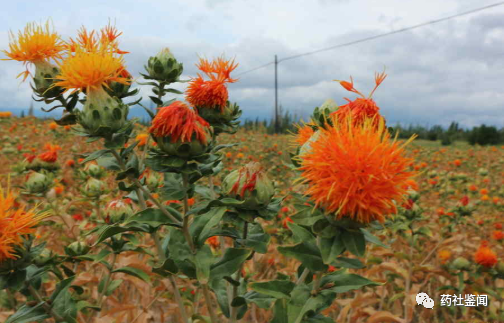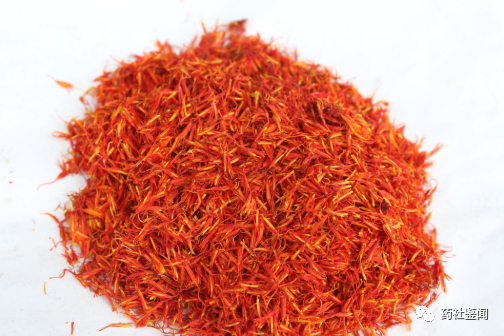SafflowerHonghuaCARTHAMI FLOS1. 2020 Edition of the Chinese Pharmacopoeia
This product is the dried flower of the Asteraceae plant, Carthamus tinctorius L. The flowers are harvested in summer when they change from yellow to red, and then dried in the shade or under sunlight.

【Properties】This product consists of tubular flowers without ovaries, measuring 1-2 cm in length. The surface is reddish-yellow or red. The corolla tube is elongated and 5-lobed at the tip, with lobes that are narrow and 5-8 mm long; there are 5 stamens, and the anthers are fused into a tubular structure, yellowish-white; the stigma is cylindrical and slightly bifurcated at the tip. The texture is soft. It has a faint fragrance and a slightly bitter taste.

【Identification】(1) The powder of this product is orange-yellow. Fragments of corolla, filaments, and stigma are commonly seen, with long tubular secretory cells often located near the ducts, approximately 66 μm in diameter, containing yellow-brown to red-brown secretions. The outer wall of the epidermal cells at the tip of the corolla lobes is protruded, resembling short hairs. The epidermal cells on the upper part of the stigma and style differentiate into conical unicellular hairs, with tips that are sharp or slightly blunt. Pollen grains are nearly round, oval, or olive-shaped, approximately 60 μm in diameter, with 3 germination pores and serrated protrusions on the outer wall. Calcium oxalate crystals are present in parenchyma cells, measuring 2-6 μm in diameter. (2) Take 0.5 g of the powdered product, add 5 ml of 80% acetone solution, seal tightly, shake for 15 minutes, let it stand, and take the supernatant as the test solution. Take 0.5 g of safflower reference material and prepare the reference solution in the same manner. Perform thin-layer chromatography (TLC) test (General Rule 0502), applying 5 μl of each solution on the same silica gel H plate, using ethyl acetate-formic acid-water-methanol (7:2:3:0.4) as the developing agent, develop, remove, and dry. In the test chromatogram, spots of the same color should appear at the corresponding positions as in the reference chromatogram. 【Examination】 Impurities must not exceed 2% (General Rule 2301). Moisture must not exceed 13.0% (General Rule 0832, Method 2). Total ash must not exceed 15.0% (General Rule 2302). Acid-insoluble ash must not exceed 5.0% (General Rule 2302). Absorbance of red pigment: Take the product, place it in a silica gel desiccator for 24 hours, grind into a fine powder, take about 0.25 g, accurately weigh, place in a conical flask, add 50 ml of 80% acetone solution, connect a condenser, and heat in a water bath at 50°C for 90 minutes, cool, filter through a No. 3 melting glass funnel, collect the filtrate in a 100 ml volumetric flask, wash with 25 ml of 80% acetone solution in portions, combine the washings into the volumetric flask, and dilute to the mark with 80% acetone solution, shake well, and measure the absorbance at 518 nm using UV-visible spectrophotometry (General Rule 0401), which must not be lower than 0.20. 【Extractable matter】 Determined by the water-soluble extractive method (General Rule 2201) using cold infusion, must not be less than 30.0%. 【Content determination】 Hydroxy safflower yellow A is determined by high-performance liquid chromatography (HPLC) (General Rule 0512). Chromatographic conditions and system suitability test: Use octadecylsilyl-bonded silica gel as the stationary phase; use methanol-acetonitrile-0.7% phosphoric acid solution (26:2:72) as the mobile phase; detection wavelength is 403 nm. Theoretical plate number calculated based on the peak of hydroxy safflower yellow A should not be less than 3000. Preparation of reference solution: Take an appropriate amount of hydroxy safflower yellow A reference substance, accurately weigh, and dissolve in 25% methanol to prepare a solution containing 0.13 mg per 1 ml. Preparation of test solution: Take about 0.4 g of the powdered product (passed through a No. 3 sieve), accurately weigh, place in a stoppered conical flask, accurately add 50 ml of 25% methanol, weigh again, perform ultrasonic treatment (power 300W, frequency 50 kHz) for 40 minutes, cool, weigh again, and make up the weight loss with 25% methanol, shake well, filter, and take the filtrate. Determination method: Accurately take 10 μl of both the reference solution and the test solution, inject into the liquid chromatography system, and measure. The product, calculated on a dry basis, must contain not less than 1.0% hydroxy safflower yellow A (C27H32O16). Kaempferol is determined by high-performance liquid chromatography (HPLC) (General Rule 0512). Chromatographic conditions and system suitability test: Use octadecylsilyl-bonded silica gel as the stationary phase; use methanol-0.4% phosphoric acid solution (52:48) as the mobile phase; detection wavelength is 367 nm. Theoretical plate number calculated based on the peak of kaempferol should not be less than 3000. Preparation of reference solution: Take an appropriate amount of kaempferol reference substance, accurately weigh, and dissolve in methanol to prepare a solution containing 9 μg per 1 ml. Preparation of test solution: Take about 0.5 g of the powdered product (passed through a No. 3 sieve), accurately weigh, place in a stoppered conical flask, accurately add 25 ml of methanol, weigh again, heat under reflux for 30 minutes, cool, weigh again, and make up the weight loss with methanol, shake well, filter, accurately measure 15 ml of the filtrate into a flat-bottom flask, add 5 ml of hydrochloric acid solution (15→37), shake well, heat in a water bath for hydrolysis for 30 minutes, cool immediately, transfer to a 25 ml volumetric flask, dilute to the mark with methanol, shake well, filter, and take the filtrate. Determination method: Accurately take 10 μl of both the reference solution and the test solution, inject into the liquid chromatography system, and measure. The product, calculated on a dry basis, must contain not less than 0.050% kaempferol (C15H10O6).

2. Chinese Herbal Pieces 【Processing】 Remove impurities. 【Properties】【Identification】【Examination】【Extractable matter】【Content determination】 same as the raw material.

【Flavor and Meridian】 Spicy, warm. Enters the Heart and Liver meridians. 【Functions and Indications】 Invigorates blood circulation, regulates menstruation, disperses blood stasis, and alleviates pain. Used for amenorrhea, dysmenorrhea, retained lochia, abdominal masses, chest pain due to blood stasis, abdominal pain due to blood stasis, stabbing pain in the chest and hypochondrium, trauma from falls, and painful sores and swellings. 【Dosage】 3-10 g. 【Caution】 Use with caution in pregnant women. 【Storage】 Store in a cool, dry place, protect from moisture and pests.

3. Identification (1) Safflower: tubular flowers without ovaries, measuring 1-2 cm in length. The surface is reddish-yellow or red. The corolla tube is elongated and 5-lobed at the tip, with lobes that are narrow and 5-8 mm long; there are 5 stamens, and the anthers are fused into a tubular structure, yellowish-white; the stigma is cylindrical and slightly bifurcated at the tip. The texture is soft. It has a faint fragrance and a slightly bitter taste. (2) Distribution: Yunnan safflower: Yunnan Sichuan safflower: Sichuan Shaanxi safflower: Shaanxi Du safflower: Ningbo, Zhejiang San safflower: Shangqiu, Henan Large San safflower: Shandong Huai safflower (also known as Huai safflower): areas of Wenxian, Qinyang, Wuzhi, and Mengxian in Henan. Safflower has strong adaptability, with characteristics of cold resistance, drought resistance, and salt-alkali tolerance, but it is sensitive to flooding, high temperatures, and humidity. It does not have strict soil requirements. To achieve high yields, it is necessary to select flat terrain with deep soil, uniform soil fertility, and good drainage, preferably following crops like soybeans, corn, or wheat, and avoid continuous cropping. (3) Harvesting and Processing 1. Harvesting: Safflower is an annual herb, sown in April, and flowers bloom from June to July. It should be harvested promptly when the flowers change from yellow to red. To avoid heavy dew during harvesting, which makes safflower difficult to dry, it is best to harvest around 10 a.m. on sunny days after the dew has dried. At this time, the bracts are slightly moist and become softer, making harvesting less prickly. 2. Processing: After harvesting, safflower should be placed in a ventilated, cool place to dry in the shade or under sunlight, avoiding moisture. Strong sunlight and intense heat should be avoided to prevent discoloration and quality degradation. (4) Authenticity Identification 1. Authentic safflower should turn golden yellow when immersed in water, and it should diffuse straight down without oily floating substances; counterfeit safflower will cause the water surface to have oily floating substances and turn red. 2. When safflower is stirred in water, authentic safflower does not easily break apart, while counterfeit safflower breaks apart easily. 3. Adding a drop of iodine to the water: authentic safflower will not change color, while counterfeit safflower will turn blue or purple. (5) Saffron: Also known as: Tibetan saffron, crocus sativus. 1. Source: The dried stigma of the Iridaceae plant, Crocus sativus. 2. Properties: Linear, three-branched, approximately 3 cm long. Dark red, with the upper part wider and slightly flattened, the edges at the top are irregularly serrated, with a short fissure on the inner side, and sometimes a small segment of yellow style remains at the bottom. Light in weight, soft in texture, without oily luster, and brittle after drying. It has a unique aroma, slightly irritating, and a slightly bitter taste. 3. Distribution: Spain, India, and in China, Tibet, Zhejiang, Jiangsu, and Shanghai. 4. Growth Environment: Saffron is suitable for planting in warmer regions during winter, preferring warm, humid conditions, being relatively cold-resistant, sensitive to flooding, and avoiding water accumulation. It thrives in fertile, well-drained sandy neutral soils rich in humus. 5. Harvesting and Processing: Harvesting: Saffron is a perennial herb, with flowering generally occurring from late October to early November. The entire flower should be harvested promptly when the buds fully open and the filaments are straightened. Since the flowering period coincides with autumn and winter, precautions should be taken against cold weather. The petals are pinched off by hand to extract the red stigmas. Processing: After harvesting, the stigmas of saffron are commonly dried using a low-temperature electric drying box at 50°C, or through vacuum freeze-drying and sun-drying methods. Different methods can lead to significant differences in saffron quality. 6. Authenticity Identification: Authentic saffron vs. counterfeit: petals of chrysanthemum; counterfeit: saffron stamens; counterfeit: corn silk.






